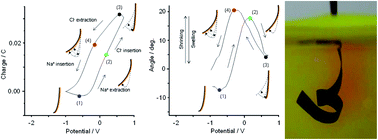Polypyrrole–para-phenolsulfonic acid/tape artificial muscle as a tool to clarify biomimetic driven reactions and ionic exchanges
Abstract
Thick films of the polypyrrole–para-phenolsulfonic acid (PPy–HpPS) blend were electrogenerated on stainless steel plates. The self-supported films, once peeled off from the metal, were electrochemically characterized in aqueous solutions of NaCl and NaPF6. The Na, Cl, P, S and F content of films, after attaining a different oxidation state, were determined by EDX. The bending movements of the bilayer (PPy–HpPS)/tape artificial muscle were video recorded during potential sweeps in both solutions allowing the translation of the prevalent ionic exchanges driven by the biomimetic reactions into macroscopic movements. Ionic exchanges between the film and the solution, biomimetic structural processes in the film, driving prevalent electrochemical reactions and film compositions related to each of the different structural potential domains defined by coulovoltammetric results were clarified. In NaPF6 solutions a prevalent exchange of anions exists: the film swells by oxidation and shrinks by reduction. In NaCl solutions prevailing exchange of cations or anions occurs in different potential ranges. Reactions related to the HpPS content play important roles at the more cathodic and more anodic overpotentials. The described methodology could be translated to biological reactions including reactive biopolymers.


 Please wait while we load your content...
Please wait while we load your content...